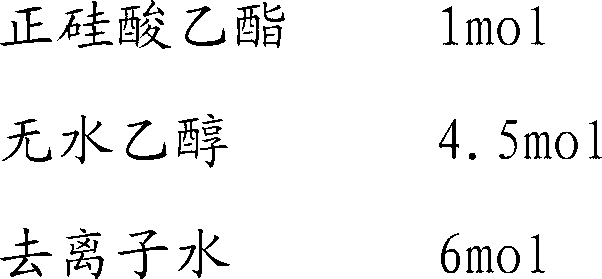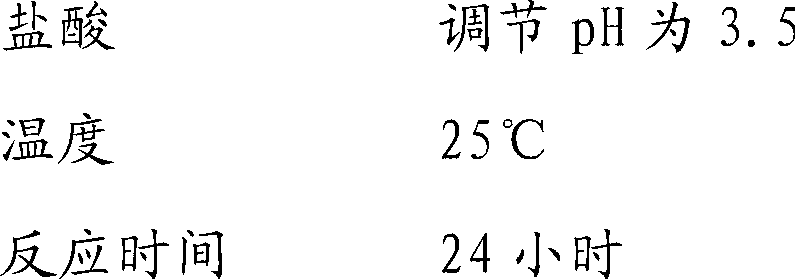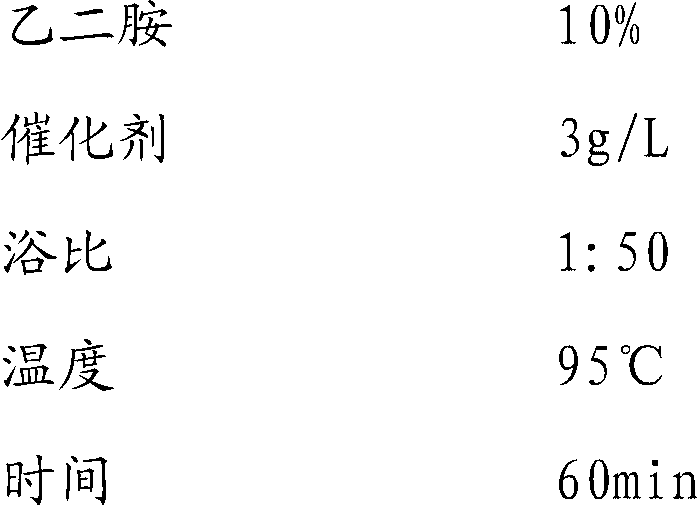Processing method for high-efficiency polyester nonwoven thermal insulation material
A technology of polyester non-woven fabrics and thermal insulation materials, applied in the field of non-woven deep processing, can solve problems such as difficulties in large-scale production and application, difficulty in construction, mechanical defects, etc., achieve breakthroughs in technology and equipment bottlenecks, increase the ability of spontaneous drainage, The effect of improving the mechanical properties
- Summary
- Abstract
- Description
- Claims
- Application Information
AI Technical Summary
Problems solved by technology
Method used
Image
Examples
Embodiment 1
[0033] 120g / m 2 , thick 1mm polyester staple fiber needle-punched nonwovens
[0034] (1) Preparation of tetraethyl orthosilicate sol working solution
[0035]
[0036]
[0037] Then, add 5% (volume fraction) of CF 3 CH 2 CH 2 OH, fully stirred evenly to obtain a sol treatment working solution.
[0038] (2) Aminolytic modification of polyester nonwoven fabric
[0039]
[0040] After dehydration, the liquid carrying rate is controlled to 75%; specifically, in this embodiment, the catalyst is sodium carbonate.
[0041] (3) Impregnated sol treatment working solution
[0042] The temperature of the working fluid is 30°C, and the liquid carrying rate is 200%. The scraper spacing is 1mm.
[0043] (4) Ladder drying conditions
[0044] 50℃×60min, 80℃×20min, 110℃×20min, 160℃×2min.
[0045] The performance of the thermal insulation material prepared by the above process is:
[0046] The average diameter of micropores in the airgel is 60nm; the thermal conductivity at ...
Embodiment 2
[0048] 180g / m 2 , 1.5mm thick polyester needle-punched nonwovens
[0049] (1) Preparation of tetraethyl orthosilicate sol working solution
[0050]
[0051] Then, add 7% (volume fraction) of CF 3 CH 2 CH 2 OH, fully stirred evenly to obtain a sol treatment working solution.
[0052] (2) Aminolytic modification of polyester nonwoven fabric
[0053]
[0054] After dehydration, the liquid carrying rate is controlled to 70%; in this embodiment, the catalyst used is sodium carbonate.
[0055] (3) Impregnated sol treatment working solution
[0056] The temperature of the working fluid is 35°C, and the liquid carrying rate is 180%. The scraper spacing is 1.5mm.
[0057] (4) Ladder drying conditions
[0058] 50℃×90min, 80℃×20min, 110℃×20min, 160℃×3min.
[0059] The performance of the thermal insulation material prepared by the above process is:
[0060] The average diameter of the micropores in the airgel is about 80nm; the thermal conductivity at normal temperature a...
Embodiment 3
[0062] 75g / m 2 , 0.75mm thick polyester melt-blown nonwovens
[0063] (1) Preparation of tetraethyl orthosilicate sol working solution
[0064]
[0065] Then, 5% (volume fraction) of CF3CH2CH2OH was added and stirred evenly to obtain a working solution for sol treatment.
[0066] (2) Aminolytic modification of polyester nonwoven fabric
[0067]
[0068] After dehydration, the liquid carrying rate is controlled at 70%.
[0069] (3) Impregnated sol treatment working solution
[0070] The temperature of the working fluid is 35°C, and the liquid carrying rate is 150%. The scraper spacing is 0.75mm.
[0071] (4) Ladder drying conditions
[0072] 50℃×45min, 80℃×15min, 110℃×15min, 160℃×2min.
[0073] The performance of the thermal insulation material prepared by the above process is:
[0074] The average diameter of the airgel is about 60nm; the thermal conductivity at normal temperature and pressure is lower than 0.038w / m k; the longitudinal breaking strength is 160N / 3...
PUM
| Property | Measurement | Unit |
|---|---|---|
| diameter | aaaaa | aaaaa |
| diameter | aaaaa | aaaaa |
| diameter | aaaaa | aaaaa |
Abstract
Description
Claims
Application Information
 Login to View More
Login to View More - R&D
- Intellectual Property
- Life Sciences
- Materials
- Tech Scout
- Unparalleled Data Quality
- Higher Quality Content
- 60% Fewer Hallucinations
Browse by: Latest US Patents, China's latest patents, Technical Efficacy Thesaurus, Application Domain, Technology Topic, Popular Technical Reports.
© 2025 PatSnap. All rights reserved.Legal|Privacy policy|Modern Slavery Act Transparency Statement|Sitemap|About US| Contact US: help@patsnap.com



